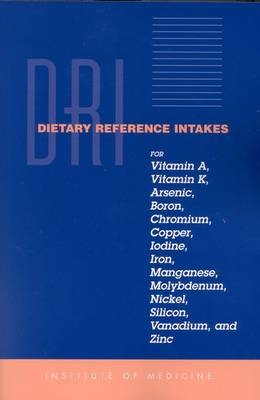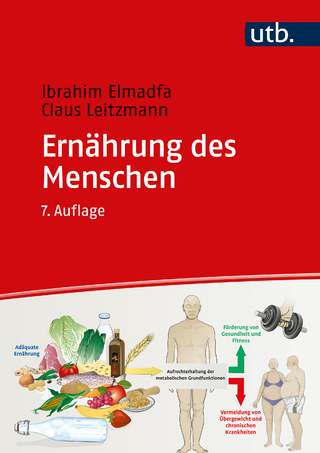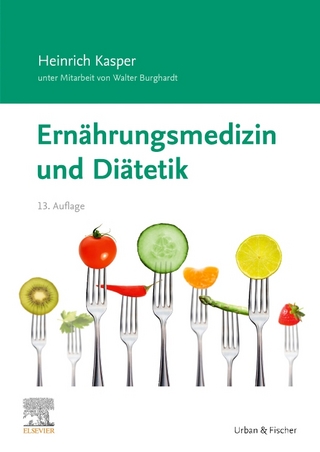
Dietary Reference Intakes for Vitamin A, Vitamin K, Arsenic, Boron, Chromium, Copper, Iodine, Iron, Manganese, Molybdenum, Nickel, Silicon, Vanadium, and Zinc
Seiten
2002
National Academies Press (Verlag)
978-0-309-07290-8 (ISBN)
National Academies Press (Verlag)
978-0-309-07290-8 (ISBN)
- Keine Verlagsinformationen verfügbar
- Artikel merken
Part of a series that provides recommended intakes, such as Recommended Dietary Allowances (RDAs), for use in planning nutritionally adequate diets for individuals based on age and gender. This volume determines Tolerable Upper Intake levels for each nutrient reviewed where adequate scientific data are available in specific population subgroups.
This volume is the newest release in the authoritative series issued by the National Academy of Sciences on dietary reference intakes (DRIs). This series provides recommended intakes, such as Recommended Dietary Allowances (RDAs), for use in planning nutritionally adequate diets for individuals based on age and gender. In addition, a new reference intake, the Tolerable Upper Intake Level (UL), has also been established to assist an individual in knowing how much is "too much" of a nutrient.
Based on the Institute of Medicine's review of the scientific literature regarding dietary micronutrients, recommendations have been formulated regarding vitamins A and K, iron, iodine, chromium, copper, manganese, molybdenum, zinc, and other potentially beneficial trace elements such as boron to determine the roles, if any, they play in health. The book also:
Reviews selected components of food that may influence the bioavailability of these compounds.
Develops estimates of dietary intake of these compounds that are compatible with good nutrition throughout the life span and that may decrease risk of chronic disease where data indicate they play a role.
Determines Tolerable Upper Intake levels for each nutrient reviewed where adequate scientific data are available in specific population subgroups.
Identifies research needed to improve knowledge of the role of these micronutrients in human health.
This book will be important to professionals in nutrition research and education.
Table of Contents
Front Matter
Summary
1 Introduction to Dietary Reference Intakes
2 Overview and Methods
3 A Model for the Development of Tolerable Upper Intake Levels
4 Vitamin A
5 Vitamin K
6 Chromium
7 Copper
8 Iodine
9 Iron
10 Manganese
11 Molybdenum
12 Zinc
13 Arsenic, Boron, Nickel, Silicon, and Vanadium
14 Uses of Dietary Reference Intakes
15 A Research Agenda
A Origin and Framework of the Development of Dietary Reference
Intakes
B Acknowledgments
C Dietary Intake Data from the Third National Health and Nutrition
Examination Survey (NHANES III), 19881994
D Dietary Intake Data from the Continuing Survey of Food Intakes by
Individuals (CSFII), 19941996
E Dietary Intake Data from the U.S. Food and Drug Administration
Total Diet Study, 19911997
F Canadian Dietary Intake Data, 1990
G Biochemical Indicators for Iron, Vitamin A, and Iodine from the
Third National Health and Nutrition Examination Survey (NHANES
III), 19881994
H Comparison of Vitamin A and Iron Intake and Biochemical
Indicators from the Third National Health and Nutrition Examination
Survey (NHANES III), 19881994
I Iron Intakes and Estimated Percentiles of the Distribution of
Iron Requirements from the Continuing Survey of Food Intakes by
Individuals (CSFII), 19941996
J Glossary and Acronyms
K Conversion of Units
L Options for Dealing with Uncertainties
M Biographical Sketches of Panel and Subcommittee Members
Index
This volume is the newest release in the authoritative series issued by the National Academy of Sciences on dietary reference intakes (DRIs). This series provides recommended intakes, such as Recommended Dietary Allowances (RDAs), for use in planning nutritionally adequate diets for individuals based on age and gender. In addition, a new reference intake, the Tolerable Upper Intake Level (UL), has also been established to assist an individual in knowing how much is "too much" of a nutrient.
Based on the Institute of Medicine's review of the scientific literature regarding dietary micronutrients, recommendations have been formulated regarding vitamins A and K, iron, iodine, chromium, copper, manganese, molybdenum, zinc, and other potentially beneficial trace elements such as boron to determine the roles, if any, they play in health. The book also:
Reviews selected components of food that may influence the bioavailability of these compounds.
Develops estimates of dietary intake of these compounds that are compatible with good nutrition throughout the life span and that may decrease risk of chronic disease where data indicate they play a role.
Determines Tolerable Upper Intake levels for each nutrient reviewed where adequate scientific data are available in specific population subgroups.
Identifies research needed to improve knowledge of the role of these micronutrients in human health.
This book will be important to professionals in nutrition research and education.
Table of Contents
Front Matter
Summary
1 Introduction to Dietary Reference Intakes
2 Overview and Methods
3 A Model for the Development of Tolerable Upper Intake Levels
4 Vitamin A
5 Vitamin K
6 Chromium
7 Copper
8 Iodine
9 Iron
10 Manganese
11 Molybdenum
12 Zinc
13 Arsenic, Boron, Nickel, Silicon, and Vanadium
14 Uses of Dietary Reference Intakes
15 A Research Agenda
A Origin and Framework of the Development of Dietary Reference
Intakes
B Acknowledgments
C Dietary Intake Data from the Third National Health and Nutrition
Examination Survey (NHANES III), 19881994
D Dietary Intake Data from the Continuing Survey of Food Intakes by
Individuals (CSFII), 19941996
E Dietary Intake Data from the U.S. Food and Drug Administration
Total Diet Study, 19911997
F Canadian Dietary Intake Data, 1990
G Biochemical Indicators for Iron, Vitamin A, and Iodine from the
Third National Health and Nutrition Examination Survey (NHANES
III), 19881994
H Comparison of Vitamin A and Iron Intake and Biochemical
Indicators from the Third National Health and Nutrition Examination
Survey (NHANES III), 19881994
I Iron Intakes and Estimated Percentiles of the Distribution of
Iron Requirements from the Continuing Survey of Food Intakes by
Individuals (CSFII), 19941996
J Glossary and Acronyms
K Conversion of Units
L Options for Dealing with Uncertainties
M Biographical Sketches of Panel and Subcommittee Members
Index
Panel on Micronutrients, Subcommittees on Upper Reference Levels of Nutrients and of Interpretation and Use of Dietary Reference Intakes, and the Standing Committee on the Scientific Evaluation of Dietary Reference Intakes
| Erscheint lt. Verlag | 19.7.2002 |
|---|---|
| Verlagsort | Washington |
| Sprache | englisch |
| Maße | 152 x 229 mm |
| Themenwelt | Medizin / Pharmazie ► Gesundheitsfachberufe ► Diätassistenz / Ernährungsberatung |
| Naturwissenschaften ► Biologie ► Biochemie | |
| ISBN-10 | 0-309-07290-5 / 0309072905 |
| ISBN-13 | 978-0-309-07290-8 / 9780309072908 |
| Zustand | Neuware |
| Haben Sie eine Frage zum Produkt? |
Mehr entdecken
aus dem Bereich
aus dem Bereich
Indikation, Diagnostik, Therapie
Buch (2024)
Thieme (Verlag)
80,00 €
Unter Mitarbeit von Walter Burghardt
Buch | Softcover (2020)
Urban & Fischer in Elsevier (Verlag)
56,00 €


